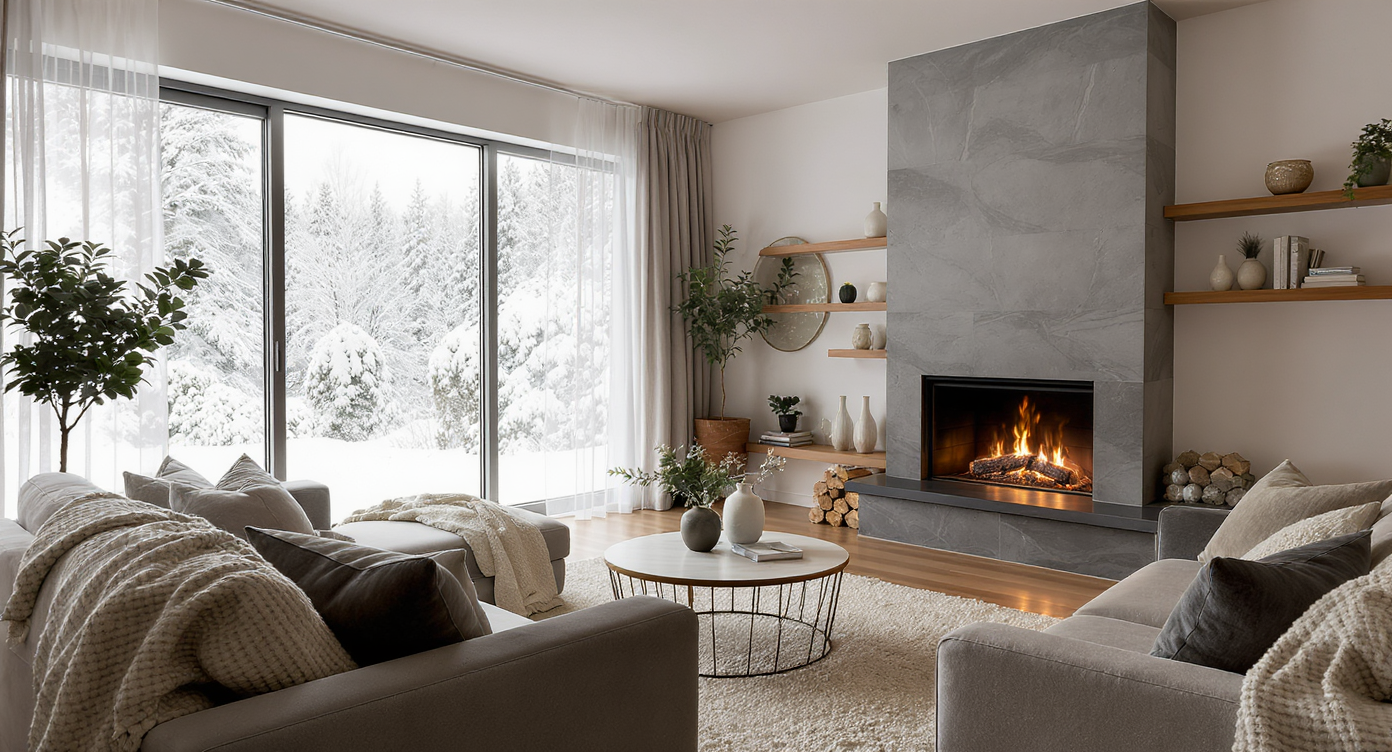TL;DR
Yes, winter can be the best time to buy a house. With fewer buyers competing, more motivated sellers, and the chance to stress-test systems in cold weather, you can negotiate confidently and make a clearer decision. If you’ve wondered about the reasons winter is the best time to buy a house, think pricing leverage, cleaner inspections, and faster timelines.
Why winter home buying works for real buyers

Winter home buying offers a chance to see cozy interiors that highlight comfort and warmth during cold months.
Here’s the thing about winter home buying: the season filters out casual shoppers. That means fewer bidding wars, more meaningful tours, and a better shot at negotiating on a home you actually want. Buyers searching for winter home buying opportunities often find a calmer market, clearer timelines, and sellers who are ready to talk.
Winter also exposes what spring hides. When it’s below freezing, you’ll feel drafty windows, hear a tired furnace, and spot condensation where insulation is weak. Designers and inspectors often note this is the one season that shows a property’s “bones.” If your goal is to buy a house you truly understand, winter is the most honest test.
There’s a human side too. Agents tend to have more time. Lenders and appraisers usually have shorter queues. If you need hands-on guidance and a steady pace, the colder months can be a gift.
The off-season edge: how to buy a house in winter
Winter home buying typically means 15%–20% fewer competing offers than spring and can yield purchase prices 3%–5% below peak-season comparables, according to many agents and transaction data trendlines. Fewer bidders plus motivated sellers is a powerful combination for a prepared buyer.
Start with strategy. If you’re eyeing a property in December through February, assume you’ll have a cleaner negotiation path. Ask for a seller credit in lieu of cosmetic fixes and apply it toward closing costs or rate buydowns. Experts often advise writing offers that balance firmness with respect: price anchored in recent comps, plus clear deadlines and clean terms.
- Use the weather. Schedule showings during a cold snap or after snowfall to test heating, insulation, and drainage. A quick rule of thumb: in a cold climate, well-insulated attics usually hit R-38 to R-49 (roughly 12–16 inches of fiberglass or cellulose).
- Run an in-the-moment systems check. Set thermostats up a few degrees and listen: a healthy furnace shouldn’t cycle rapidly. Touch exterior walls and window frames for drafts. Look for icy dams along eaves and stained sheathing in the attic.
- Audit water management. Snowmelt should flow away from the foundation; puddles near the house signal grading or gutter issues. In basements, watch for efflorescence lines or musty odors, both early flags for moisture.
- Ask for paperwork. Request 12 months of utility bills to estimate winter operating costs; many homes see heating expenses 20%–40% higher than shoulder seasons.
Financing and timing can also favor you. With fewer transactions in the pipeline, closings often land in 30–35 days instead of 40–50. That tighter window can lock in a rate sooner and cut carrying costs. One buyer insight: even with leverage, avoid lowballing. Many sellers will choose the respectful, well-documented offer over the highest number if it feels more certain to close.
Suggested image alt text: winter home buying exterior with snow, buyer checking roof and gutters. Suggested caption: Winter reveals how a house handles cold, snow, and drainage in real time.
Anecdote
On a sleety afternoon, a buyer noticed the neighbor’s sump pump discharging into a snowbank right at the fence line. That single clue led to a deeper drainage review and a small price concession for grading fixes—and a much drier basement come spring.
Common winter home-buying mistakes to avoid
Winter home buyers most often stumble by underestimating weather logistics and overestimating their leverage. A thoughtful process prevents both.
- Skipping roof visibility. Snow can hide shingles. Solution: add a post-thaw inspection clause or request drone photos taken prior to snowfall.
- Ignoring drainage in freeze–thaw. Icicles and pooled meltwater near the foundation are warning signs. Ask for gutter cleaning and downspout extensions in negotiations.
- Lowballing because “it’s winter.” Motivated doesn’t mean desperate. Lean on comps and inspection findings to justify price; keep tone collaborative.
- Not testing everything. Buyers forget to run exterior hose bibs, garage doors, or attic fans when it’s cold. Turn it all on. If it’s installed, it should function.
- Overlooking light. Shorter days shrink perceived brightness. Tour once in daylight. If rooms feel dim, budget for layered lighting and higher LRV paint.
Experts recommend attaching a short, practical repair list to offers, prioritizing safety, structure, and water over cosmetics. That keeps negotiations focused and winnable.
Pro tips for winter buyers (that agents swear by)
Serious winter buyers win by pairing market leverage with forensic touring habits and clean contract terms. The goal is speed with depth.
- Request seasonal service records. A recently serviced boiler or furnace with a clean filter says a lot. Ask for the last service date and any warranty info.
- Use a rate buydown creatively. With fewer bids, seller credits can fund a 1–2 point temporary buydown or permanent rate reduction. Lenders can model break-even timelines.
- Write a snow-smart offer. Add a roof re-inspection right after thaw and a cap on seller-paid repairs based on inspection thresholds.
- Plan for light. In spaces facing north, designers often advise 300–500 lumens per square meter via mixed sources. Put “lighting plan” on your post-close checklist.
- Check attic depth fast. Pop the hatch: if insulation is below the joists, you likely need a top-up. Aim for R-49 in cold regions; it’s a high-ROI upgrade.
Reflection: Every great winter purchase I’ve seen paired empathy with evidence. Buyers who listened to a seller’s timeline and backed it with airtight paperwork usually saved money and stress.
Real stories: winter buyers who made it work
Stories make the data real. These winter snapshots show what smart buyers noticed and how it changed their deals.
- The draft test that paid for itself. A couple touring a 1950s ranch felt a chill by the bay window. Their inspector found failed seals in two panes and thin attic insulation. They negotiated a $7,500 credit, used $2,800 for new windows, and blew cellulose to R-49. Their first winter bills dropped noticeably.
- Snowmelt told the truth. An investor noticed melt lines forming faster over one roof bay than the rest, a classic heat-loss sign. Infrared confirmed missing insulation above a hallway. The seller agreed to remedy before close and provide photos. That fix likely prevented ice dams the next storm.
- Respect beat the lowball. Another buyer offered near ask but with an aggressive close, a rent-back to help the seller relocate, and a modest credit for safety fixes. They beat a slightly higher number and still came in about 3% below spring comps for the block.
- The quiet agent advantage. In January, a first-time buyer got three showings in two days with their agent, plus a same-week lender pre-underwrite. They closed in 32 days, sidestepping the spring scramble entirely.
Suggested image alt text: buyer testing windows for drafts in winter living room. Suggested caption: Cold weather makes air leaks and tired systems much easier to spot.
Visualization Scenario
Imagine stepping from a crunchy, snow-dusted sidewalk into a living room that actually feels warm at the corners. No drafts tickle your ankles. The furnace hums steadily, not frantically. You tap the thermostat, tour the attic, and watch icicles forming where the gutters are clogged—easy leverage for a credit. Later that night, you drop the floor plan into ReimagineHome, test a layered lighting scheme for short winter days, and realize the north-facing office will sing with the right paint and task lamps. That’s the winter advantage: truth on the tour, clarity after.
Winter home buying: quick answers
- Is winter a good time to buy a house?
Yes. Winter home buying usually brings less competition, more motivated sellers, and a clearer read on heating, insulation, and drainage performance. - What are the top reasons winter is the best time to buy a house?
Fewer competing offers, stronger negotiation leverage, faster timelines with agents/lenders, and better inspections under cold-weather stress. - How do I inspect a house in winter?
Tour during a cold snap, test heating by raising thermostats, check for drafts at windows/doors, review 12-month utility bills, and assess roof/attic for ice dams. - Do sellers accept lower offers in winter?
Often, yes—experts note 3%–5% below peak-season pricing is common when paired with clean terms and comps-based justification. - Is winter a good time to lock a mortgage rate?
It can be. Slower pipelines often mean quicker closings; discuss rate locks and buydowns with a lender to capture favorable movements.
What winter gives you that spring can’t
Winter won’t magically make every listing a bargain, but it tilts the field toward the prepared. With fewer competing offers, motivated sellers, and the gift of real-time stress tests, cold-weather shopping can deliver value you won’t find in May. Bring a clear offer, a smart inspection plan, and a little empathy for timing. The warmest part of the process might be the deal you make.
Ready to picture your furniture and lighting plan before you move? Use ReimagineHome to visualize layouts, test color and lighting, and plan upgrades room by room after you close.
.svg)

.svg)









.png)